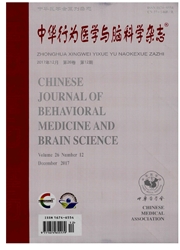

 中文摘要:
中文摘要:
目的探讨单胺氧化酶A基因30bp串联重复序列多态性(MAOA—uVNTR)对中青年重性抑郁症患者大脑灰质密度的影响。方法应用聚合酶链式反应(PCR)技术扩增目的基因,1.5%琼脂糖凝胶电泳分离,将56例抑郁症患者以及37例性别比例、年龄、受教育年限上差异无显著性的健康对照分为低活性基因型组(3R,3R/4R)和高活性基因型组(4R),93例受试者均经结构磁共振(MRI)扫描头部。结果①抑郁症患者组和正常对照组间基因型及等位基因分布频率差异无统计学意义(尸〉0.05)。②与正常对照组相比,抑郁症患者左右尾状核(K=11/68,Z=3.76/4.76)、左右丘脑(K=21/181,Z=3.26/3.63)、右下丘脑(K=38/12,Z=4.20/3.60)灰质密度显著降低。③高活性基因型患者组较低活性基因型患者组左右尾状核(K=17/33,z=3.23/4.36)、左壳核(K=16,Z=3.42)、右下丘脑(K=12,Z=3.62)灰质密度显著降低。高活性基因型组患者组较同基因型健康组左尾状核(K=11,Z=4.13)、左右丘脑(K=13/14,Z=3.53/3.23)、左海马旁回(K=13,Z=4.04)密度显著降低。结论高活性基因型可能是引起抑郁症患者边缘系统-纹状体-苍白球-丘脑环路结构异常的一个重要因素。
 英文摘要:
英文摘要:
Objective To explore the impact of the variable number of tandem repeats of monoamine oxidase A gene (MAOA-uVNTR) on the concentration of gray matter in patients with major depressive disorders. Methods 56 cases of depression, as well as 37 healthy controls who were matched in gender, age and years of education were divided into low-activity genotype (3R or 3R/4R), and high-activity genotype (4R) with the methods of polymerase chain reaction (PCR) amplification and 1.5% agarose gel electrophoresis separation. 93 cases all were performaned structural magnetic resonance imaging scanning. Results ① The difference of genotype and allele frequeney between the depression group and the healthy group was not statistically significant (P 〉 0.05 ). (1) Compared with the healthy,the concentration of gray matter (GMC) of bilateral caudate nucleus (K = 11/68, Z = 3.76/4.76), bilateral thalamus ( K = 21/181, Z = 3.26/3.63 ) and right hypothalamus ( K = 38/12, Z = 4.20/ 3.60) reduced significantly in depressed patients. (2) In patients with depression,cases with the high-activity genotype showed reduced GMC bilateral caudate nucleus ( K = 17/33, Z = 3.23/4.36 ) , left putamen ( K = 16, Z = 3.42) and right hypothalamus ( K = 12,Z = 3.62) in comparision with patients with low-activity genotype. In highactivity genotype group,compared with the healthy,patients with depression had reduced GMC in left caudate nucleus ( K = 11, Z = 4. 13 ), bilateral thalamus ( K = 13/14, Z = 3.53/3.23 ) and left parahippoeampal gyrus ( K = 13, Z =4.04). Conclusion High-activity genotype may be an important factor contributing to the structural abnormalitily of the limbic-striatum-globus pallidus-thalamus loop.
 同期刊论文项目
同期刊论文项目
 同项目期刊论文
同项目期刊论文
 Multichannel matching pursuit of MEG signals for discriminative oscillation pattern detection in dep
Multichannel matching pursuit of MEG signals for discriminative oscillation pattern detection in dep 期刊信息
期刊信息
